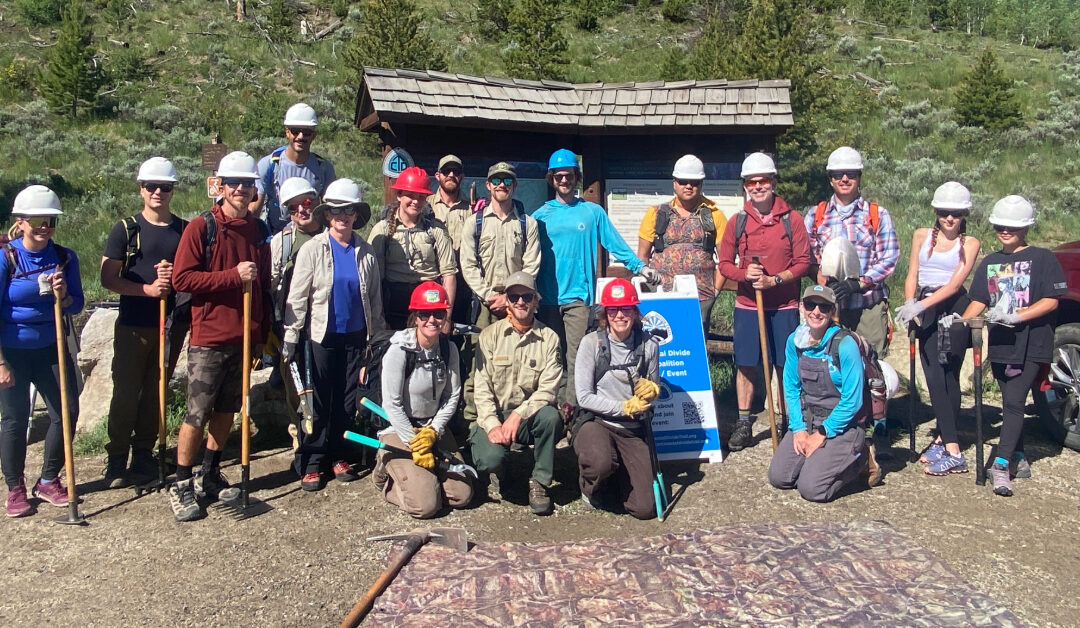Trail Protection
Preserving the Continental Divide Trail Experience
More than just an 18-inch-wide path, the CDT Experience relies on landscape-scale conservation to protect the Continental Divide and preserve the CDT Experience. Landscape-scale conservation is the holistic approach to the conservation of lands, waters, and skies that brings together people across geographies, borders, and cultures to cooperatively steward landscapes on which communities depend to provide ecological, cultural, health, economic, and other community benefits. As a National Scenic Trail, the CDT is a connector for communities and an anchor to protect the important natural, historic, and cultural resources of the Divide.
Priority landscapes along the CDT include the Sky Islands of New Mexico, the Great Gila River Watershed, the Rio Grande Headwaters and Greater Chaco Region, the Intermountain Region of Colorado, the High Plains and Peaks of Wyoming’s Basins, the Greater Yellowstone Ecoregion, and the Northern Rockies Corridor connecting to the Crown of the Continent in Glacier National Park. These priority areas are unique jewels strung together by the common thread of the CDT, providing an interconnected network of natural and human-made systems that depend on one another to remain resilient, vibrant, and healthy.

How We Preserve the CDT Experience?
Learn about what CDTC is doing to protect the Divide and complete the CDT- and how you can get involved!
Where Do We Focus Our Work?
From local communities to international coalitions, CDTC is committed to supporting community-led action that supports a resilient Divide landscape.
What’s New in Trail Protection?
Activity is always happening along the Divide – learn about impacts to the CDT and your local community!
Atlas of the CDT
The Continental Divide National Scenic Trail connects ecosystems and communities spanning the length of a nation along the spine of the Rocky Mountains. This Atlas presents the CDT in its full monumental scale – with thematic maps, infographics, and writing that explore the history and context of the trail corridor and its regional setting. Open to discover the landscapes of the CDT and the work done to establish, grow, and complete the trail.
Beyond the Trail Tread
The Continental Divide National Scenic Trail (CDT) climbs and descends along the Rocky Mountains from Mexico to Canada, traversing 3,100 miles across an incredibly biodiverse and unique landscape, connecting cultures and communities through the healing properties of the outdoors. CDTC works to elevate the holistic benefits of a vibrant Divide landscape including community connection, sustainable economic growth, improved public health, and environmental preservation.
Trail Completion & Connectivity
Completion of the CDT to provide a continuous footpath along the Divide will help to connect the entire Divide landscape! Beyond just a north-south route, CDTC works with communities and partners to provide greater connectivity for community access.
Lands, Waters, and Skies
Connectivity goes beyond the trail! Improved connectivity on the Divide leads to a healthier landscape for wildlife and plant habitat, free-flowing waters, and the preservation of dark skies. Learn more by downloading the Atlas of the CDT.
History & Culture of the Divide
This landscape holds a complex history with many cultural and historical values that tell the stories of the people and places of the Continental Divide. The CDT can be an anchor for more equitable stewardship and more inclusive enjoyment of the lands, waters, and skies of the Divide, particularly for people historically excluded from the benefits of the outdoors.
Community-led Conservation
At the frontlines of impacts to the CDT, are the communities the trail connects. CDTC works with Gateway Communities and other communities along the Divide landscape to ensure that the benefits of the CDT and the outdoors are aligned with the priorities of those who will be most impacted.
Cooperative Stewardship of the Divide
The CDT is unique in connecting a wide variety of unique ecosystems and pockets of biodiversity across the continent. Stewardship of the Divide landscape is a cooperative initiative that involves federal agencies, Sovereign Nations, national and local trail organizations, communities, private landowners, corporations, recreationists, and other partners and stakeholders. CDTC utilizes the CDT as a place for these different interests to convene and plan for a future that meets our shared goals of a healthy, resilient Continental Divide landscape.
Federal Stewardship
The CDT traverses the spine of the Rocky Mountains connecting 21 National Forests and 1 National Monument managed by the Forest Service, 13 BLM Resource Areas, and 4 National Park Units, including El Malpais National Monument.
Indigenous Stewardship
For time immemorial, Indigenous people have been the stewards of the Divide. Across the trail, CDTC works with Tribal Governments of multiple Sovereign Nations, Indigenous communities, traditional Hispanic communities, acequia communities, and others to ensure that priorities of the original stewards of these lands and waters continue to be centered in landscape-scale conservation efforts.
State & Local Stewardship
The CDT travels through 5 trail states including Montana, Idaho, Wyoming, Colorado, and New Mexico, and works with state and local governments to ensure consistent management of the CDT.
Private Stewardship
Private landowners and lessees have, in some cases, managed the lands the CDT traverses for generations. Private parcels and managers help to provide access to the CDT, healthy lands for connectivity, and active management on a local level for a national resource.
The Latest in Trail Protection

“Trail Work is a Bottomless Pit” – Why Volunteering is More Important than Ever
"Trail Work is a Bottomless Pit" - Why Volunteering is More Important than Ever By Michael McDaniel I CDTC Technical Field Specialist “Trail work is a bottomless pit.” It was a joke first...
